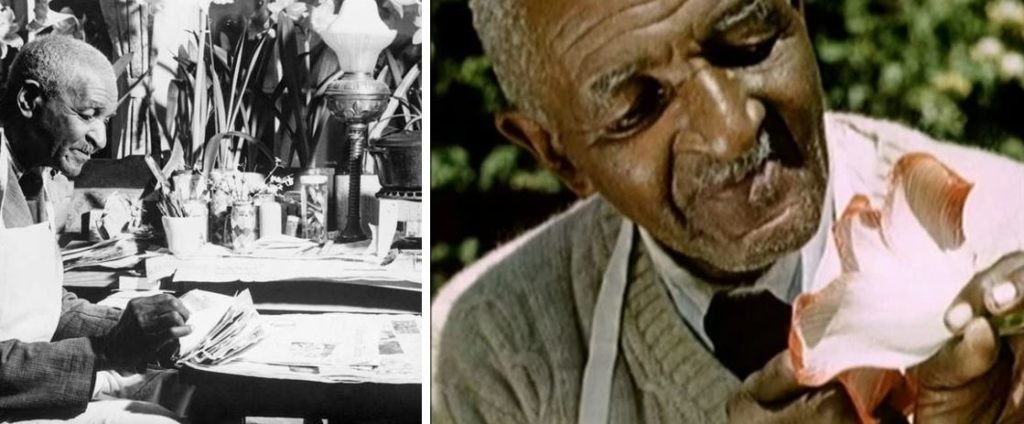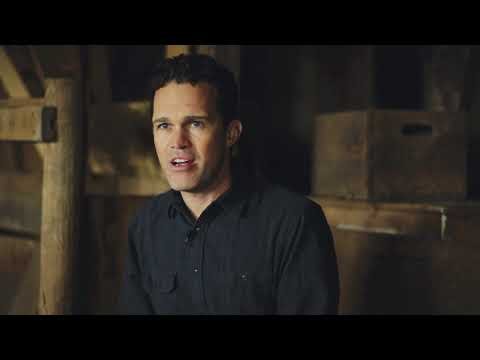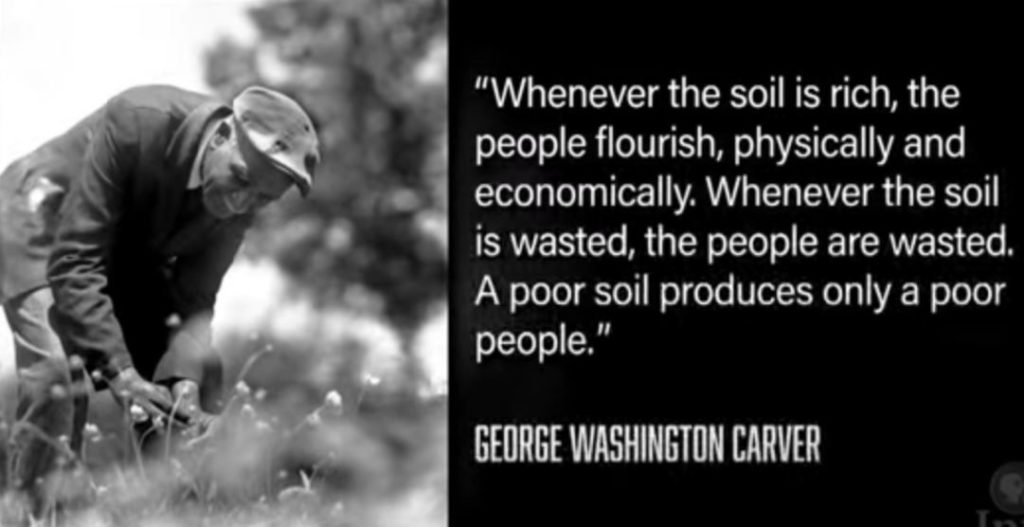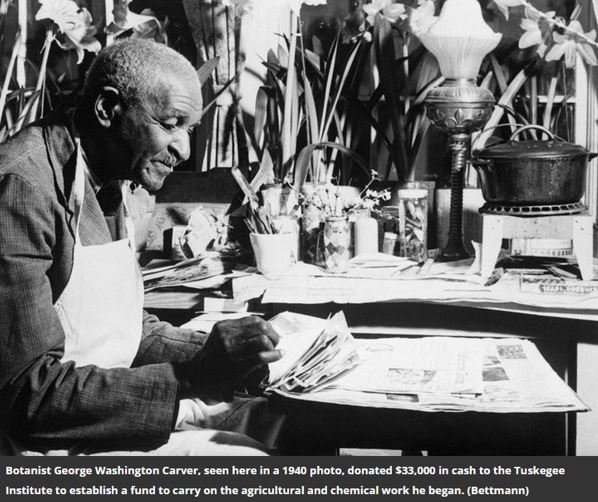By Neenah Payne
Dr. George Washington Carver created regenerative agriculture which is key to our survival now. Wikipedia says:
“Regenerative agriculture has a long history and can be traced to the agricultural extension work of Dr. George Washington Carver at Tuskegee University in the early part of the 20th century, as well as Carver's scientific contributions regarding the nitrogen cycle and the biological regeneration of soils in the southern United States where he introduced crop rotation methods in combination with the planting of nitrogen-fixing legumes, such as peanuts, peas, and soybeans."
Dr. Zach Bush points out that we are in the Sixth Great Extinction now and human survival depends on the urgent restoration of our soils to provide nutritious foods. He connects not only America’s health, but our financial and political survival to the health of our soil. Our reliance on GMO foods is causing healthcare to bankrupt us. He says converting to organic farming is not sufficient because most organic farmers till the soil -- which is as destructive as GMO pesticides! When farmers switch to regenerative agriculture, their yields rise from $40 to $500-$900 per acre and they see improvements the first year! Dr. Bush partners with The Soil Health Academy which educates farmers on how to convert to regenerative agriculture. A million acres in the US have been regenerated. His goal is to convert five million more acres. Farmer’s Footprint helps support farmers in the transition.
Dr. Bush says on his site:
“My work is dedicated to the health of humanity and the planet we call home. It is critical that our pursuit of optimal health and longevity begin with an effort toward a collective rise in consciousness such that we would begin to thrive within nature, instead of fighting that nature that is life itself. My experience as a physician specializing in internal medicine, endocrinology and hospice care with a focus on the microbiome as it relates to health, disease, and food systems led me to found the non-profit Farmer’s Footprint to develop root-cause solutions for human and ecological health. My passion for education reaches across many disciplines, including the role of soil and water ecosystems in human genomics, immunity, and gut/brain health. My education has highlighted the need for a radical departure from chemical farming and pharmacy, and ongoing efforts to create a path for consumers, farmers, and mega-industries to work together for a healthy future for people and planet.”
Film: Regenerative Agriculture -- A Paradigm Shift
Dr. Bush says about the free film on his site Farmer’s Footprint: A Path To Soil Health and Food Independence:
“This film features the trials, learnings and victories of the four generation Breitkreutz family from Stoney Creek Farm transitioning from conventional farming to regenerative agriculture in Redwood Falls, Minnesota. Using conventional methods they saw their soils degrade and their input costs rise every year. Transitioning to regenerative practices has helped their row cropping operation and significantly reduced the input cost for their cattle. This film tells the story of how they did it.”
CSAs Are Thriving
Hidden Roots of Community Supported Agriculture (CSA) shows that Booker T. Whatley, Dr. Carver’s student, created CSAs which are helping make millions of Americans more food secure now.
Here’s why CSAs are thriving during the pandemic
As Food Supply Chain Breaks Down, Farm-To-Door CSAs Take Off
Dr. Carver’s Legacy
George Washington Carver (1864? -- 1943) was an agricultural chemist, agronomist and botanist who developed 300 products from peanuts, 100 from sweet potatoes, and soy-beans that radically changed the agricultural economy of the United States. Carver won several awards for his contributions. He spent most of his career teaching and conducting research at the Tuskegee Normal and Industrial Institute (now Tuskegee University) in Tuskegee, Alabama.
The Overlooked History of Regenerative Agriculture and CSAs in America says:
“George Washington Carver was born enslaved in Missouri around 1864 and was freed shortly after the Civil War (which ended in 1865.) From boyhood, he had a strong interest in plants, eventually becoming the first black student at Simpson College in Iowa and getting a Master of Science in botany and agriculture in 1896.
Carver’s study and work was centered around supporting Black southern farmers in the wake of the Civil War…..Carver had to learn and understand the limitations— socially, politically, and financially— facing Black farmers at this time….Carver worked with these Black farmers in an effort to create lucrative, productive farms. He showed them how to replenish the poor-quality soil, stripped of its nutrition as a result of monocropping cotton and tobacco for many years. Carver encouraged crop rotation, told farmers to begin growing and foraging their own vegetables and protein to save on food costs, and showed them how to use compost in the place of expensive commercial fertilizers.
Carver encouraged these farmers to understand their land and the seasonal cycles. While many farmers were still growing cotton, Carver introduced peanuts into their crop rotation, providing a nitrogen rich product to grow in their fields in the cotton off-season….In researching the fats, oils, sugars and gums of the peanut, he also found how profitable growing this nut could be for these farms. Not only would it restore the land, but nuts could serve as food for livestock and farmers, in addition to the profits that could be made through selling peanuts and their oil."
George Washington Carver, An Introduction
The 2002 book George Washington Carver reports on “The amazing story of George W. Carver, slave birth, Iowa State graduate and Tuskegee Professor who revolutionized the economy of the south by discovering hundreds of uses for the peanut.”
George Washington Carver: A Life says:
“The many tributes honoring his contributions to scientific advancement and black history include a national monument bearing his name, a U.S.-minted coin featuring his likeness, and induction into the National Inventors Hall of Fame. Born into slavery, Carver earned a master’s degree at Iowa State Agricultural College and went on to become that university’s first black faculty member. A keen painter who chose agricultural studies over art, he focused the majority of his research on peanuts and sweet potatoes….
His scientific breakthroughs with the crops―both of which would replenish the cotton-leached soil of the South―helped spare multitudes of sharecroppers from poverty. Despite Carver’s lifelong difficulties with systemic racial prejudice, when he died in 1943, millions of Americans mourned the passing of one of the nation’s most honored and well-known scientists. Scores of children’s books celebrate the contributions of this prolific botanist, but no biographer has fully examined both his personal life and career until now….
Despite the exceptional trajectory of his career, Carver was not immune to the racism of the Jim Crow era or the privations and hardships of the Great Depression and two world wars. Yet throughout this tumultuous period, his scientific achievements aligned him with equally extraordinary friends, including Teddy Roosevelt, Mohandas Gandhi, Henry A. Wallace, and Henry Ford….Vella’s extensively researched biography offers a complex and compelling portrait of one of the most brilliant men of the last century.”
Book: My Work Is That of Conservation: An Environmental Biography of George Washington Carver
Amazon Description
“In My Work Is That of Conservation, Mark D. Hersey reveals the life and work of this fascinating man who is widely―and reductively―known as the African American scientist who developed a wide variety of uses for the peanut….Carver’s environmental vision came into focus when he moved to the Tuskegee Institute in Macon County, Alabama, where his sensibilities and training collided with the denuded agrosystems, deep poverty, and institutional racism of the Black Belt. It was there that Carver realized his most profound agricultural thinking, as his efforts to improve the lot of the area’s poorest farmers forced him to adjust his conception of scientific agriculture..”
In Search of George Washington Carver’s True Legacy
“If the name George Washington Carver conjures up any spark of recognition, it’s probably associated with peanuts. That isn’t an unfair connection—he did earn the nickname 'the peanut man' for his work with the legume—but it’s one that doesn’t give credit to the rest of Carver’s pioneering, fascinating work. 'People, when they think of Carver, they think of his science—or they think he invented peanuts,' says Curtis Gregory, a park ranger at the George Washington Carver National Monument at Carver’s birthplace in Diamond, Missouri. 'There’s so much more to the man.'
Mark Hersey, a history professor at Mississippi State University and author of an environmental biography of Carver… In Hersey’s view, the contributions Carver made to the environmental movement, including his ahead-of-the-times ideas about self-sufficiency and sustainability, are far more important than the 'cook-stove chemistry' he engaged in. Nonetheless, Carver became ludicrously famous for his peanut work—possibly the most famous black man in America for a while. Upon his death in 1943, President Franklin D. Roosevelt remarked on his passing: 'The world of science has lost one of its most eminent figures,' he said."
The article adds:
“Upon graduation from Iowa State in 1896, Carver was bombarded with offers to teach. The most attractive was that from Booker T. Washington, the first leader of the Tuskegee Institute, which was opening an agricultural school. As the first black man in the U.S. to receive graduate training in modern agricultural methods, Carver was the logical choice for the role. He accepted, writing that 'it has always been the one great ideal of my life to be of the greatest good to the greatest number of ‘my people’ possible and to this end I have been preparing myself these many years; feeling as I do that this line of education is the key to unlock the golden door of freedom to our people.'
As Carver rode the train to Alabama, however, his heart sank. In a 1941 radio broadcast, he recalled: 'My train left the golden wheat fields and the tall green corn of Iowa for the acres of cotton, nothing but cotton ... The scraggly cotton grew close up to the cabin doors; a few lonesome collards, the only sign of vegetables; stunted cattle, boney mules; fields and hill sides cracked and scarred with gullies and deep ruts ... Not much evidence of scientific farming anywhere. Everything looked hungry: the land, the cotton, the cattle, and the people.'
What Carver understood was that cotton, while lucrative, did nothing to replenish the soil. It’s not the most demanding crop, but its shallow roots, and the practice of monocropping, mean that soil erodes faster from a cotton field than if the earth was left alone….
Still, Carver got to work. He worked tirelessly—the Carver Monument says from 4 a.m. to 9 p.m. some days—on improving crop yields and encouraging farmers to diversify. That, too, was tough: Financially lucrative cotton, Hersey says, was seen as the only crop that could get tenants out of debt. Carver encouraged farmers to grow, or at the very least forage, their own vegetables and proteins so they would spend less money on food. Later, he developed and implemented the Jesup Agricultural Wagon, a school-on-wheels that brought agricultural equipment and demonstration materials to rural farmers unable to travel. The wagon reached 2,000 people a month in its first summer of operations, in 1906…
Carver encouraged farmers to look to the land for what they needed, rather than going into debt buying fertilizer (and paint, and soap, and other necessities—and food). Instead of buying the fertilizer that 'scientific agriculture' told them to buy, farmers should compost. In lieu of buying paint, they should make it themselves from clay and soybeans.
'He gave black farmers a means of staying on the land. We all couldn’t move north to Chicago and New York,' Michael Twitty, a culinary historian, told the Chicago Tribune. And that’s where the peanuts come in. Peanuts could be grown in the same fields as cotton, because their productive times of year were different. While some plants need to be fertilized with nitrogen, peanuts can produce their own, thanks to a symbiotic relationship with bacteria that live on their roots. That special trait meant they could restore nutrients to depleted soil, and they were 'an enormously rich food source,' high in protein and more nutritious than the '3M--meat, meal and molasses' diet that most poor farmers subsisted on.
Carver encouraged farmers to grow peanuts, but then he had to encourage them to do something with those peanuts, hence his famous '300 uses for peanuts.' Carver’s peanut work led him to create peanut bread, peanut cookies, peanut sausage, peanut ice cream, and even peanut coffee. He patented a peanut-butter-based face cream, and created peanut-based shampoo, dyes and paints, and even the frightening-sounding 'peanut nitroglycerine.'"
The article points out:
“Carver’s ubiquitous association with peanuts is in many ways due to the explosive testimony he delivered before Congress in favor of a peanut tariff. In 1921, the U.S. House Ways and Means Committee asked Carver to testify on a proposed tariff on imported peanuts. Expecting an uneducated backwoodsman, the committee was blown away by the soft-spoken scientist. 'He’s had thousands of public speaking appearances at this point,' Hersey says. 'He can handle it all. [Congress] is making watermelon jokes, but they’re not saying anything he hasn’t already heard at the Georgia State Fair.' The tariff on imported peanuts stuck, and Carver became, in Hersey’s words, 'a rockstar.'"
The article concludes:
“Late in his life, a visitor asked Carver if he believed his peanut work was his greatest work. 'No,' he replied, 'but it has been featured more than my other work.'
So what was his work? Hersey argues it was a way of thinking holistically about the environment, and an understanding, well before it had reached mainstream thought, of the interconnectedness between the health of the land and the health of the people who lived on it. 'His campaign is to open your eyes to the world around you,' Hersey says, to understand, in Carver’s phrase, 'the mutual dependency of the animal, vegetable, and mineral kingdoms.' …years before the environmental movement took hold, Twitty told the Tribune, 'Carver knew the value of working the land, of being with the land, of working with each other.'"
"Struggle and Triumph: The Legacy of George Washington Carver"
List of Products Made From Peanut By George Washington Carver
Dr. George Washington Carver's work resulted in the creation of more than 300 products from peanuts, contributing greatly to the economic improvement of the rural South. Below is a list of some of his peanut products.
Modern Marvels: George Washington Carver Tech - Full Episode (S12, E8) | History
There are now 50,000 peanut farms in the South.
George Washington Carver: An Uncommon Life
George Washington Carver's rise from slavery to scientific accomplishment has inspired millions. This documentary reveals the full impact of his life and work.
Top image composite: Smithsonian/History
Neenah Payne writes for Natural Blaze and Activist Post
Originally posted here: https://hive.blog/health/@activistpost/dr-george-washington-carver-s-creation-can-save-humanity-now







No comments:
Post a Comment